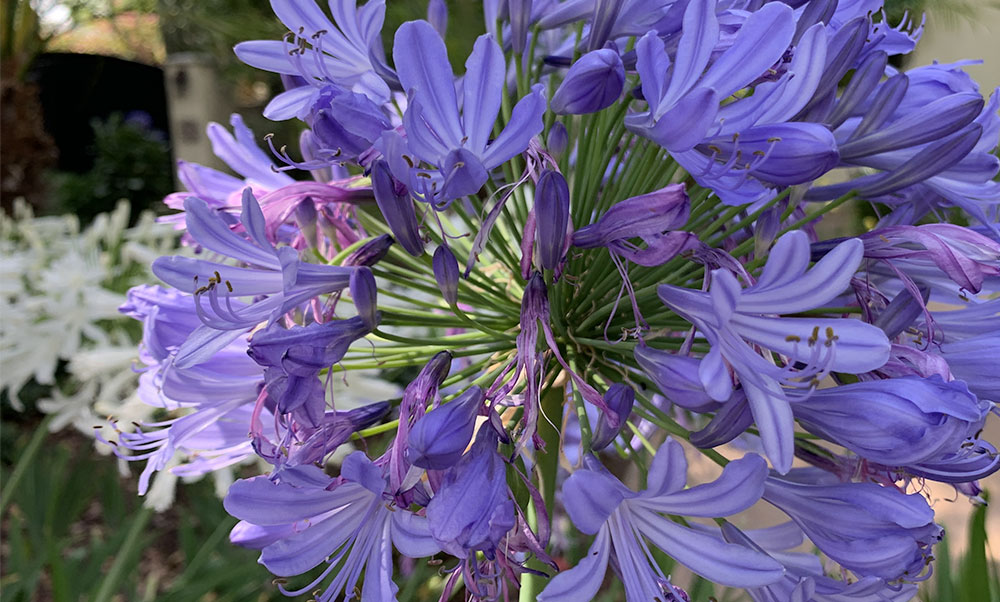Some of Australia’s favourite garden plants are secretly causing big trouble in the wild. Many were introduced for their beauty or toughness, but they’ve since escaped into bushland, outcompeting native species, harming wildlife, and changing entire ecosystems.
The good news? For every problem plant, there’s a native that does the same job — without the environmental cost. Here’s what to look out for and what to plant instead.
1. Agapanthus (Agapanthus praecox)
Originally from: South Africa
Why it’s popular: Hardy, drought-tolerant, and loved for bold purple or white flower clusters.
The problem: Spreads by seed and rhizomes, forming dense clumps that smother native plants and stop bush regeneration.
Try instead:
Blue flax lily (Dianella caerulea)
A tough native with strappy leaves and dainty purple flowers. Tolerates dry shade, attracts birds with its berries, and looks great in borders and under trees.
2. Wandering trad (Tradescantia fluminensis)
Originally from: South America
Why it’s popular: A quick-growing groundcover for shady spots.
The problem: Smothers native plants, erodes stream banks, and is toxic to pets. Even tiny fragments can regrow.
Try instead:
Native violet (Viola hederacea)
A gentle native groundcover with round leaves and sweet violet and white flowers. Great for moist, shaded spots and safe for pets.
3. Cotoneaster (Cotoneaster spp.)
Originally from: Asia
Why it’s popular: Popular as a dense hedge with bright red berries.
The problem: Birds spread the seeds into bushland, where it forms dense thickets that push out native species.
Try instead:
Blueberry ash (Elaeocarpus reticulatus)
A graceful small tree or shrub with fringed pink or white flowers and bright blue berries that attract birds. Lovely as a screen or feature plant.
4. English ivy (Hedera helix)
Originally from: Europe
Why it’s popular: A fast-growing evergreen climber that covers fences and walls.
The problem: Escapes gardens, climbs and strangles trees, and smothers the understorey.
Try instead:
Native clematis (Clematis aristata)
A vigorous native climber with starry white flowers. Ideal for fences and pergolas, and safe for bushland.
5. Lantana (Lantana camara)
Originally from: Central and South America
Why it’s popular: Colourful flowers and extremely tough.
The problem: One of Australia’s worst weeds — toxic to stock, outcompetes native plants, fuels bushfires, and spreads rapidly.
Try instead:
Thyme honey-myrtle (Melaleuca thymifolia)
A hardy native shrub with soft foliage and masses of purple flowers. Attracts bees and butterflies and suits most soils.
6. African lovegrass (Eragrostis curvula)
Originally from: Southern Africa
Why it’s popular: Often used for erosion control and pasture.
The problem: Highly invasive, outcompetes native grasses, reduces pasture quality, and is very flammable.
Try instead:
Kangaroo grass (Themeda triandra)
A striking native grass with arching leaves and coppery seed heads. Perfect for natural plantings, erosion control, and habitat restoration.
7. Arum lily (Zantedeschia aethiopica)
Originally from: South Africa
Why it’s popular: Beautiful white blooms and lush foliage for damp spots.
The problem: Invades wetlands and waterways, toxic to people and stock.
Try instead:
Swamp lily (Crinum pedunculatum)
A dramatic native with strappy leaves and large white lily-like flowers. Great for moist, shady areas — lush but not invasive.
8. Sweet pittosporum (Pittosporum undulatum)
Native to: NSW and QLD — but invasive in VIC, SA, and parts of WA.
Why it’s popular: Fast-growing, fragrant flowers, popular for screens.
The problem: Outside its natural range, it becomes dominant and suppresses native plants.
Try instead:
Coastal rosemary (Westringia fruticosa)
A hardy native shrub with grey-green leaves and soft white to mauve flowers. Great for hedging, drought-tolerant, and wildlife friendly.
A more thoughtful garden
By planting natives that match the look and function of their invasive counterparts, you’re creating a garden that’s more than just beautiful — it’s part of Australia’s ecological solution.
- Support native birds, bees, and butterflies
- Stop the spread of garden escapees into bushland
- Work with your climate, not against it
- Weeds Australia (Centre for Invasive Species Solutions) — weeds.org.au
- WeedWise (NSW Department of Primary Industries) — weeds.dpi.nsw.gov.au
- Atlas of Living Australia — ala.org.au
